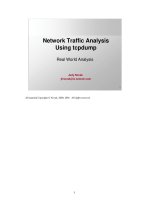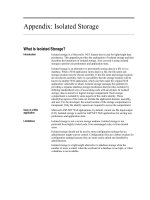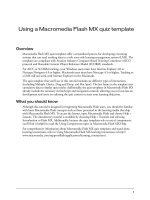Tài liệu interacting with oracle docx
Bạn đang xem bản rút gọn của tài liệu. Xem và tải ngay bản đầy đủ của tài liệu tại đây (287.6 KB, 36 trang )
Interacting with Oracle
22
Introduction to Oracle: SQL and PL/SQL Using Procedure Builder22Ć2
Schedule: Timing Topic
40 minutes Lecture
45 minutes Practice
85 minutes Total
Class Management Note:
Files required for lesson.
Demonstration: l22cust.pls, l22newsd.pls, l22delr.pls
Practice: None
Interacting with Oracle 22Ć3
Objectives
In this lesson, you access the database and control transactions through SQL
statements in PL/SQL.
At the end of this lesson, you should be able to
D
Use SELECT, INSERT, UPDATE, and DELETE commands in PL/SQL
subprograms.
D
Determine the outcome of SQL statements by using implicit cursor attributes.
D
Control transactions within PL/SQL.
Introduction to Oracle: SQL and PL/SQL Using Procedure Builder22Ć4
Class Management Note:
Remind students that they will combine the commands covered in this
lesson with the subprograms learned in the previous lessons.
Interacting with Oracle 22Ć5
Overview
When you need to extract information from or apply changes to the database, you
must use SQL. PL/SQL supports full data manipulation language and transaction
control commands within SQL. You can use SELECT statements to populate
variables with values queried from a row in a table. Your DML commands can
process multiple rows.
Comparing SQL and PL/SQL Statement Types
D
A PL/SQL block is not a transaction unit. Commits, savepoints, and rollbacks are
independent of blocks, but you can issue these commands within a block.
D
PL/SQL does not support data definition language (DDL), such as CREATE
TABLE, ALTER TABLE, or DROP TABLE.
D
PL/SQL does not support data control language (DCL), such as GRANT or
REVOKE.
D
DBMS_SQL package allows you to issue DDL and DCL statements.
Class Management Note:
DBMS_SQL package is a new package available in Oracle7 Release 7.2.
For more information about DBMS_SQL package, see Oracle7 Server
Application Developer’s Guide, Release 7.2.
Introduction to Oracle: SQL and PL/SQL Using Procedure Builder22Ć6
Class Management Note:
The INTO clause is required in a SELECT statement in PL/SQL. This is in
contrast to SQL, where the INTO clause is forbidden.
Output variables are PL/SQL variables through which values pass from the
database out to the PL/SQL block. The datatype of an output variable must
be compatible with the datatype of the source column, although the source
column may be an expression; in particular, Boolean variables are not
permitted.
Input variables are PL/SQL variables through which values pass from the
PL/SQL block into the database.
Interacting with Oracle 22Ć7
Retrieving Data Using PL/SQL
Use the SELECT statement to retrieve data from the database. The SELECT
statement contains an additional mandatory clause: the INTO clause. In the INTO
clause, list the output variables for receiving the data. The SELECT statement must
return exactly one row or an error will occur.
Abridged Syntax
SELECT select_list
INTO variable_name | record_name
FROM table
WHERE condition;
where: select_list is a list of at least one column, and can include
SQL expressions, row functions, or group
functions.
variable_name is the scalar variable to hold the retrieved value.
record_name is the PL/SQL RECORD to hold the retrieved
values.
table specifies the database table name.
condition is composed of column names, expressions,
constants, and comparison operators, including
PL/SQL variables and constants.
Take advantage of the full range of Oracle7 Server syntax for the SELECT statement.
Guidelines
D
Terminate each SQL statement with a semicolon (;).
D
Assign values into PL/SQL tables in a loop by declaring an explicit cursor.
D
The INTO clause is required for the SELECT statement when it is embedded
within PL/SQL.
D
The WHERE clause is optional, and can be used to specify input variables,
constants, literals, or PL/SQL expressions.
Introduction to Oracle: SQL and PL/SQL Using Procedure Builder22Ć8
Interacting with Oracle 22Ć9
Retrieving Data Using PL/SQL
continued
Guidelines
D
Specify the same number of output variables in the INTO clause as database
columns in the SELECT clause. Be sure that they correspond positionally and that
their datatypes are compatible.
D
Ensure that the datatype of the identifiers match the datatype of the columns by
using the %TYPE attribute. The datatype and number of variables in the INTO
clause match those in the SELECT list.
D
Terminate the PL/SQL block with the END statement. You can add the name of
the subprogram after the keyword END for clarity.
D
Include at least one RETURN statement in a function.
D
Use group functions, such as SUM, in a SQL statement since group functions
apply to groups of rows in a table.
Class Management Note:
On the board, write: v_sum_salaries := SUM (s_emp.salary),
and draw a line through it to emphasize that group functions must be used
in a SQL statement.
Introduction to Oracle: SQL and PL/SQL Using Procedure Builder22Ć10
Class Management Note:
Question: Ask students what the record structure looks like.
Answer: Three fields, ID, NAME, and REGION_ID.
Question: Ask students how to reference the value in the NAME field of the
record.
Answer: Reference the value as DEPT_RECORD.NAME.
Interacting with Oracle 22Ć11
Retrieving Data Using PL/SQL
continued
A PL/SQL RECORD can be used to easily create fields that match a database table’s
columns. Each field has the same name and datatype as a column in the table. When
retrieving all columns from a table, use a PL/SQL RECORD to hold the retrieved
values.
Class Management Note:
Note for page 22-16.
Question: Ask students how to change the code to avoid receiving the error.
Answer: Name the identifiers with the v_ prefix.
Introduction to Oracle: SQL and PL/SQL Using Procedure Builder22Ć12
Interacting with Oracle 22Ć13
Retrieving Data Using PL/SQL
continued
Avoid ambiguity in the WHERE clause by adhering to a naming convention that
distinguishes database column names from PL/SQL variable names.
Example
Retrieve the order date and the ship date for the specified order. This example raises
an unhandled runtime exception.
PROCEDURE order_info
(id s_ord.id%TYPE)
IS
date_ordered s_ord.date_ordered%TYPE;
date_shipped s_ord.date_shipped%TYPE;
BEGIN
SELECT date_ordered, date_shipped
INTO date_ordered, date_shipped
FROM s_ord
WHERE id = id;
...
END order_info;
PL/SQL> order_info (100);
ERROR 0 at line 1, column 0
Unhandled exception ORA-01422: exact fetch returns
more than requested number of rows
ORA-06512: at line 7
PL/SQL checks whether an identifier is a column in the database; if not, it is assumed
to be a PL/SQL identifier.
Technical Note:
There is no possibility for ambiguity in the SELECT clause because any
identifier in the SELECT clause must be a database column name. There is
no possibility for ambiguity in the INTO clause because identifiers in the
INTO clause must be PL/SQL variables. Only in the WHERE clause is
there the possibility of confusion.
Introduction to Oracle: SQL and PL/SQL Using Procedure Builder22Ć14
Class Management Note:
Exceptions are covered in a later lesson.









